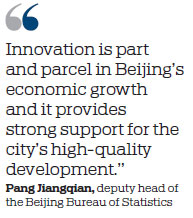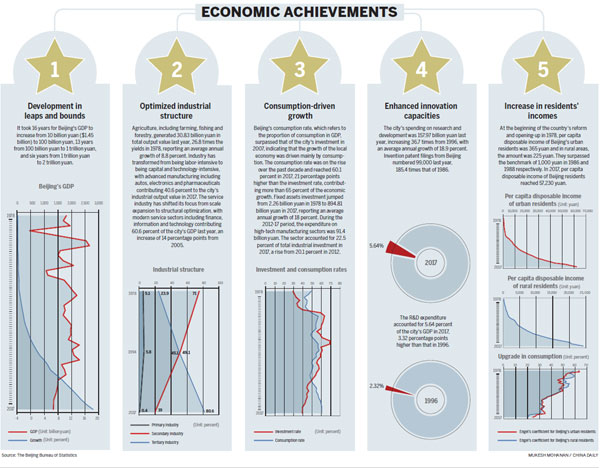Booming numbers demonstrate city's progress
GDP of $406 billion is 41.2 times the corresponding figure when reform, opening-up began
With continuous efforts in reform and opening-up, Beijing has achieved remarkable progress in its economic growth and social development over the past 40 years, officials said.
In 2017, Beijing's GDP reached 2.8 trillion yuan ($406.15 billion), 41.2 times the corresponding figure in 1978, according to the city's statistics bureau.

Beijing has rapidly developed its economy and has seen continuous growth in its comprehensive strength during the past four decades, said Pang Jiangqian, deputy head of the Beijing Bureau of Statistics, at a news conference earlier this month.
The capital has moved forward in innovation with increasing investment since the beginning of China's reform and opening-up, Pang said.
Last year, the city's expenditure on research and development reached 157.97 billion yuan, accounting for 5.64 percent of its GDP.
"Innovation is part and parcel in Beijing's economic growth and it provides strong support for the city's high-quality development," she said.
Beijing's innovation in science and technology has also facilitated the emergence of new industries, new forms of business and new business models and promotes the area's industrial upgrade and integration, she added.
In 2017, the city attracted 76,000 new tech companies, 1.7 times more than that of 2010.
Last year, the volume of contracts in the technology market reached 448.53 billion yuan, 31 times that of 2000 and an average annual growth rate of 22.6 percent.
In addition to the innovation sector, the capital's residents' income has witnessed rapid growth.
In 1978, the per capita disposable income of urban residents in Beijing was 365 yuan; that figure increased to 62,000 yuan in 2017.
The per capita disposable income of rural residents surged from 225 yuan in 1978 to 24,000 yuan in 2017.
"With the increasing demand for labor and more employment opportunities, salary has become a main part in residents' income," said Fang Xiaodan, spokesperson for the Survey Office of the National Bureau of Statistics in Beijing.
In recent years, the further expansion of market access and the promotion of mass entrepreneurship have also brought opportunities for acquiring higher income through running businesses, she said.
In 2017, Beijing residents' wage income hit 35,000 yuan. Consumption has changed with the increasing level of income, Fang said.
The Engel's co-efficient of urban and rural residents was 19.8 percent and 24.7 percent in 2017 respectively, down by 38.9 and 38.5 percentage points from 1978. The coefficient is a major indicator of people's living standard internationally. It refers to the proportion of income spent on food to individuals' total consumption expenditure.
Entertainment-related consumption has become main part in people's daily consumption, she said. "Sectors including tourism, education and culture are new trends in consumption."
With the prosperity in consumer markets, consumption patterns such as online shopping have also helped to meet people's increasing demands and contributed to economic growth, she said.
liangkaiyan@chinadaily.com.cn

(China Daily 12/27/2018 page12)














